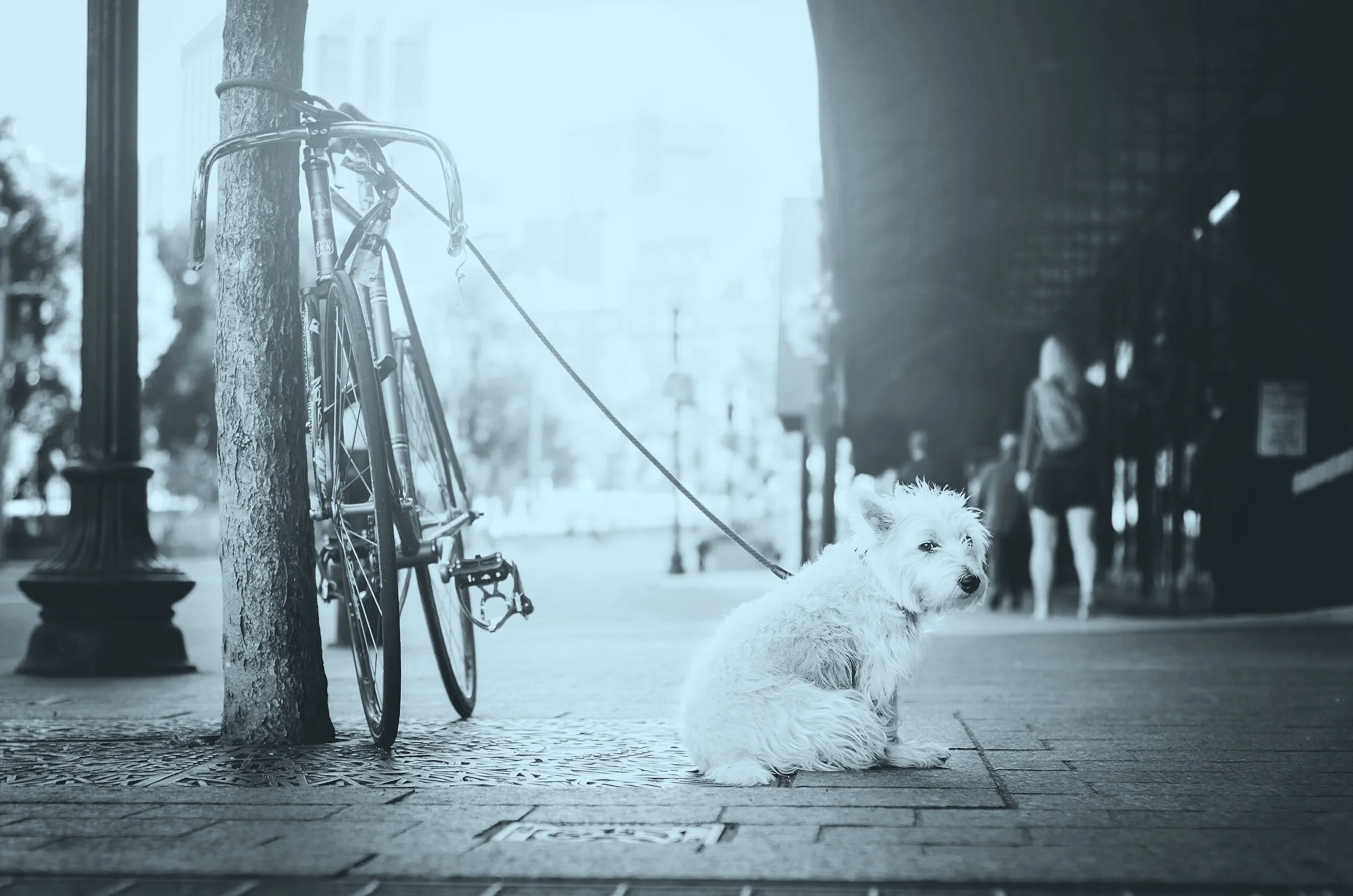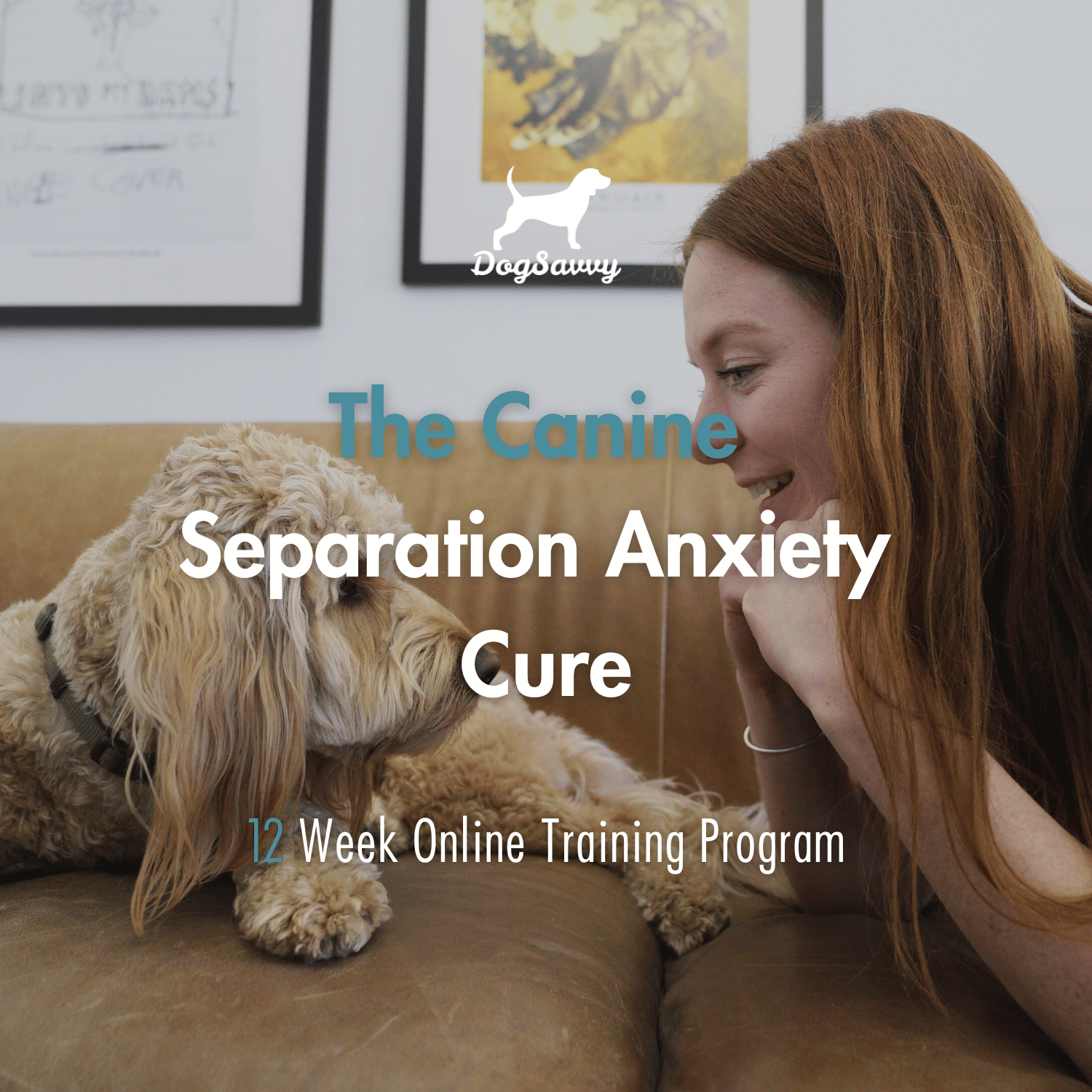Dog Separation Anxiety - Symptoms, Causes, and Treatment
What is Dog Separation Anxiety?
When a dog can’t tolerate being confined, left alone, or separated from its guardian
Dog separation anxiety is a panic disorder that occurs when a dog becomes distressed by not being able to see, access, or follow their guardian or another bonded “pack member.”
This anxiety is most often triggered when a dog is:
Separated from their guardian, preferred caregiver, or bonded animal companion
Confined alone in a crate, pen, or room
Blocked by barriers like closed doors, baby gates, or fences
Left alone at home, in the car, or in the yard
Dropped off somewhere unfamiliar like a daycare, boarding facility, groomer, or even a friend’s house
Symptoms can vary widely—from mild signs like not eating or drinking, to moderate behaviors like chronic barking, whining, or destructiveness, to extreme panic responses such as escape attempts that lead to self-injury or significant damage to your home.
Symptoms Ranging from Mild to Severe
A Boston Terrier with separation anxiety was so panicked by being confined in a bathroom that it tried to chew through a door.
Symptoms of dog separation anxiety can range from mild to severe and can include any combination of the following chronic, stress-induced behaviors:
Not eating or drinking or mild depression (when a dog lies around and avoids contact with others).
Anxiety before a guardian leaves home or extreme excitement upon their return home.
Loss of bladder and bowel control in an otherwise housetrained dog.
Frantic scratching, digging, and chewing on the sides of a crate, playpen, or kennel (or any barrier such as a closed door, gate, or fence.
Pacing or circling in a fixed pattern, trembling and shaking, or stress panting (when a dog pants heavily despite not having been exercised), often accompanied by whale eye (when a dog’s eyes bulge in its sockets).
Destructive chewing on anything nearby. Anxious dogs may chew on anything within reach—crate bedding or pans, furniture near exit doors, or personal belongings left out in the open. This behavior is often a coping mechanism for the panic they feel when left alone.
Persistent distress vocalizations. Some dogs express their anxiety through nonstop crying, whining, barking, or howling when left alone. In severe cases, the distress is so intense that they may sound as if they’re screaming, especially when confined to a crate or pen.
Excessive drooling (when a dog becomes soaked in its drool), excessive shedding (when a pile of hair falls to the floor), and unusually sweaty paws (that leave wet paw prints on the floor).
Extreme escape attempts that may or may not be successful but can result in self-harm (such as broken nails, teeth, and bones), destruction to one’s home (such as when a dog chews on doors and thresholds), or a dog getting lost or killed (because they jump out a window, over a fence, or off a balcony).
Symptoms Appear Immediately or Within the First Few Minutes
In most cases, signs of separation anxiety appear immediately or within the first few minutes of a dog being confined, separated from a loved one, or left alone—and typically do not subside after 30 minutes.
In some instances, dogs may show a delayed reaction—especially if they’re unsure whether their guardian has truly left. In these cases, symptoms may not begin until 15 to 20 minutes after separation, though this is relatively uncommon.
Unfortunately, once a dog’s stress response is triggered, the symptoms often persist until they are either released from confinement, reunited with their guardian, or become exhausted and shut down.
But shutting down isn’t the same as emotional recovery—it’s a survival mechanism, not a resolution. That’s why the stress response tends to repeat and intensify over time, eventually becoming an ingrained habit if not properly addressed.
This is why dog separation anxiety rarely improves on its own, but worsens over time, making it difficult—if not impossible—to leave your dog alone, turning what should be a joyful relationship into a daily struggle.
Crate Anxiety vs. Separation Anxiety
If your puppy becomes distressed only when confined to a crate or playpen—but remains calm when given freedom to roam—they may be experiencing crate anxiety (also known as confinement intolerance), rather than true separation anxiety.
👉 It’s important to note that separation anxiety is sometimes confused with crate anxiety.
To tell the difference, try these simple tests:
Test 1: Confine your puppy while staying in sight. If your puppy still becomes anxious, confinement—not separation—is likely the issue.
Test 2: Leave your puppy alone with full access to a safe space (no crate). If they remain calm, it’s another sign that separation isn’t the root cause.
Understanding the difference is key to providing the right support.
👉 Want to learn more? Read our blog post: How to Identify Dog Separation - And How to Rule It Out.
What Causes Dog Separation Anxiety?
Instincts, Events, and Situations that Trigger the Behavior
Dogs suffering from separation anxiety are most likely to display the behavior in the following situations:
When a rescue dog or puppy gets adopted and is separated from its new guardian for the first time (and every time thereafter)
When a rescue dog or puppy is put in a crate or playpen or left alone for the first time (and every time thereafter)
After a rescue dog or puppy gets used to constant human contact but is suddenly left alone (such as when everyone goes back to work or school after a holiday)
After the sudden loss of a beloved family member or another pet due to breakups, divorce, or death
After a dramatic change in routine or schedule like when a person moves to a new city or spends less time at home because of work
When being dropped off at a daycare, boarding, or grooming facility for the first time
After suffering a traumatic event such as abandonment, change in ownership, or too much time spent in insolation (like dogs who have been chained up their whole lives before being rescued)
The Role of Pack Instincts
Survival instincts are involuntary responses to changes in the environment that all dogs are born with, designed to help keep them alive. Pack instincts are one such instinct.
Since survival in the wild for pack animals dictates staying together at all costs, pack instincts compel a dog to keep an eye on their fellow pack members and follow them wherever they go.
This is why our dogs follow us from room to room inside the home and why dogs with this condition feel trapped even when left in the safety of their home.
Ultimately, the condition would be better categorized as a “pack instinct disorder” brought on by a dog’s natural urge to roam with “the pack” being thwarted by the “unnatural” circumstances of being kept as a pet (that can’t go everywhere their human pack members go).
A Low Tolerance for Frustration
Recent research shows that a low tolerance for frustration is one of the factors that can contribute to the development of separation anxiety in dogs.
Just like people, some dogs struggle to cope when things don’t go their way. When a dog has a low frustration threshold, they’re more likely to react impulsively—through excessive barking, destructive chewing, or frantic behavior—especially when they’re confined or left alone.
Over time, these behaviors can become habitual coping mechanisms, reinforcing the stress response and making it harder for the dog to calm down without help.
In essence, this reflects a lack of emotional regulation or coping skills. But the good news is that dogs can learn better ways to handle their frustration.
With a structured, supportive separation anxiety training plan, your dog can develop the ability to self-soothe, settle, and relax—even when faced with temporary separation or confinement.
Hormone-Induced Panic: It’s Partly Biochemical
When a dog becomes increasingly distressed from being confined or left alone, its body undergoes a biochemical chain reaction that makes it nearly impossible to settle down without help.
As frustration builds, the brain triggers a surge of cortisol (the stress hormone) into the bloodstream. At the same time, the amygdala—the brain’s emotional and survival center—takes over. This part of the brain is designed to act fast in emergencies, bypassing the slower, more rational cerebral cortex to respond to perceived threats immediately.
This direct signal from the thalamus to the amygdala activates the fight-or-flight response, flooding the body with adrenaline. The result? A dog that’s suddenly supercharged with energy, frantically barking, pacing, trying to escape, or even injuring itself in the process.
This explains how some dogs can bend crate bars, break out of enclosures, or seem “possessed” when their separation anxiety is triggered.
Much like a human experiencing a panic attack, your dog’s reaction isn’t a choice—it’s partly biochemical. That’s why punishment doesn’t work and why compassionate, structured training is essential for helping your dog learn to feel safe and relaxed when alone.
Abandonment Trauma
Some rescue dogs who’ve experienced a sudden, unexplained separation from their previous guardian—whether intentional or accidental—may suffer from what we call abandonment trauma.
As a result, they may feel compelled to closely monitor their new guardian’s whereabouts, following them from room to room to avoid being left behind again.
You might also notice heightened anxiety before departures, especially when packing for a trip, or extreme distress when leaving your dog at daycare, the groomer, or the vet. Even staying with a friend or family member can be stressful for a dog with abandonment trauma—especially if they don’t know them well.
In some cases, intense panic behaviors like chewing through doors or jumping off balconies may be due to a lack of early crate training, which helps dogs develop coping skills. But these reactions can also stem from long periods of isolation or a traumatic abandonment, both of which can leave lasting psychological scars.
👍 The good news? Fortunately, with the right support and an effective separation anxiety training plan that builds trust and confidence, dogs with abandonment trauma can recover and feel secure again.
How to Prevent Dog Separation Anxiety
Early crate and playpen training is one of the most effective ways to prevent separation anxiety—especially in puppies.
The key is to plan ahead and have the right tools in place before your new dog comes home. With a crate, a playpen, and a few enrichment toys, you’ll be ready to start building your puppy’s confidence from day one.
💡 How to set your dog up for success:
Bring your puppy home during a time when you’re available, like a long weekend, holiday break, or planned time off work.
Avoid leaving your puppy alone for long periods in the first few weeks.
Ask friends, family, or neighbors for help checking in on your puppy if you need to be away for extended hours.
The goal is to give your puppy time to adjust, bond with you, and gradually learn that being alone is safe—not scary.
👉 Want to learn more? Read our blog posts:
Crate Training as a Preventive Tool
Crate training (also called confinement training) helps your new puppy or rescue dog get used to spending time away from you in a safe, secure space.
By scheduling regular “downtime” in a crate or playpen throughout the day, your dog learns that being alone or separated doesn’t mean something bad will happen. Pairing these sessions with enrichment items like stuffed Kongs or long-lasting chews helps create positive associations with being confined.
Ideally, crate or pen time should coincide with times when you’re busy, working, or preparing to leave the house. This helps your dog gradually get used to your absence without feeling shocked or abandoned when you're actually gone.
Special Considerations for Rescue Dogs
If you’ve just adopted a rescue dog, prevention can be more challenging—especially if their past is unknown.
Some rescue dogs may panic the first time they’re left alone in an unfamiliar home. In these cases, it’s important to give your dog time to settle in and learn your household routine before introducing alone-time or crate training. Sometimes, this gentle adjustment period is enough to prevent anxiety from taking hold.
However, if your dog was abandoned, neglected, or frequently left alone in the past, they may already have developed separation-related distress. In these situations, the anxiety may stem from trauma or long-term habit, and treatment—not prevention—is necessary.
How to Treat Dog Separation Anxiety
Condition a Dog to Self-soothe and Relax When Confined or Left Alone
Dog separation anxiety can be successfully treated by systematically conditioning your dog to relax during confinement and short periods of separation from their loved ones.
This is best achieved through a combination of:
Regular crate and pen training that helps your dog feel calm and secure while confined or restrained. (We call this Decompression Training.)
Gradual exposure to your departure routine to help your dog remain relaxed when you leave home. (We call this Alone Training.)
When done correctly, the combined use of Decompression and Alone Training allows your dog to form a new habit of relaxation—without ever being pushed into distress or frustration.
Each step is designed to be manageable, helping your dog build emotional resilience and confidence over time.
The Canine Separation Anxiety Cure
Help Your Dog Overcome Separation Anxiety in 8 to 12 Weeks
Still struggling? Don’t give up—relief is possible!
If you’ve tried everything to help your dog but nothing has worked, you’re not alone—and there is hope. With the right separation anxiety training plan and a bit of patience, your dog can learn to feel calm and secure when left alone.
At Dog Savvy, we create a customized training plan tailored to your dog’s specific needs and provide one-on-one expert guidance and support every step of the way—until your dog is fully rehabilitated.
Ready to get started?
Book an intro session today to speak directly with a dog separation anxiety specialist and begin your dog’s path to calm, confidence, and independence.
About the Author
Alexandra Bassett is the owner, dog trainer, and behavior consultant at Dog Savvy, a private dog training company specializing in game-based dog training and solving problem dog behaviors like dog separation anxiety, leash reactivity, excessive barking, and aggression.
She is certified as Knowledge Assessed by the Council of Professional Dog Trainers (CPDT-KA) and is available for online dog training sessions via Zoom.











Can’t leave your dog alone? Don’t lose hope—there is a solution.
If your dog struggles with separation anxiety, our virtual training program provides a gentle, effective approach that helps dogs become calm, confident, and comfortable when left alone—often in just 8 to 12 weeks.
Take the first step toward peace of mind and a happier, more relaxed dog.
👉 Book your Intro Session now!